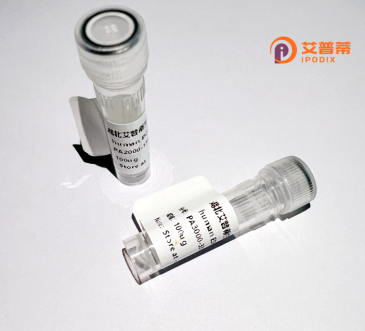
| 纯度 | >90%SDS-PAGE. |
| 种属 | Human |
| 靶点 | TRIM8 |
| Uniprot No | Q9BZR9 |
| 内毒素 | < 0.01EU/μg |
| 表达宿主 | E.coli |
| 表达区间 | 1-551 aa |
| 活性数据 | MAENWKNCFE EELICPICLH VFVEPVQLPC KHNFCRGCIG EAWAKDSGLV RCPECNQAYN QKPGLEKNLK LTNIVEKFNA LHVEKPPAAL HCVFCRRGPP LPAQKVCLRC EAPCCQSHVQ THLQQPSTAR GHLLVEADDV RAWSCPQHNA YRLYHCEAEQ VAVCQYCCYY SGAHQGHSVC DVEIRRNEIR KMLMKQQDRL EEREQDIEDQ LYKLESDKRL VEEKVNQLKE EVRLQYEKLH QLLDEDLRQT VEVLDKAQAK FCSENAAQAL HLGERMQEAK KLLGSLQLLF DKTEDVSFMK NTKSVKILMD RTQTCTSSSL SPTKIGHLNS KLFLNEVAKK EKQLRKMLEG PFSTPVPFLQ SVPLYPCGVS SSGAEKRKHS TAFPEASFLE TSSGPVGGQY GAAGTASGEG QSGQPLGPCS STQHLVALPG GAQPVHSSPV FPPSQYPNGS AAQQPMLPQY GGRKILVCSV DNCYCSSVAN HGGHQPYPRS GHFPWTVPSQ EYSHPLPPTP SVPQSLPSLA VRDWLDASQQ PGHQDFYRVY GQPSTKHYVT S |
| 分子量 | 61.4 kDa |
| 蛋白标签 | His tag N-Terminus |
| 缓冲液 | PBS, pH7.4, containing 0.01% SKL, 1mM DTT, 5% Trehalose and Proclin300. |
| 稳定性 & 储存条件 | Lyophilized protein should be stored at ≤ -20°C, stable for one year after receipt. Reconstituted protein solution can be stored at 2-8°C for 2-7 days. Aliquots of reconstituted samples are stable at ≤ -20°C for 3 months. |
| 复溶 | Always centrifuge tubes before opening.Do not mix by vortex or pipetting. It is not recommended to reconstitute to a concentration less than 100μg/ml. Dissolve the lyophilized protein in distilled water. Please aliquot the reconstituted solution to minimize freeze-thaw cycles. |
以下是关于TRIM8蛋白的3-4条参考文献及其简要摘要:
---
1. **文献名称**:*TRIM8 regulates the NF-κB signaling pathway through ubiquitination of TAK1*
**作者**:Shibata et al. (2016)
**摘要**:该研究发现TRIM8通过泛素化修饰TAK1(转化生长因子β激活激酶1),正向调控NF-κB信号通路,从而在先天免疫应答和炎症反应中起关键作用。
2. **文献名称**:*TRIM8 modulates the β-catenin/TCF4 axis to enhance chemoresistance in colorectal cancer*
**作者**:Carofalo et al. (2020)
**摘要**:研究揭示了TRIM8在结直肠癌中通过稳定β-catenin蛋白,激活Wnt/β-catenin信号通路,促进肿瘤细胞耐药性和转移,提示其作为潜在治疗靶点。
3. **文献名称**:*TRIM8 inhibits HCV replication by targeting the viral NS5A protein for ubiquitin-mediated degradation*
**作者**:Hatakeyama et al. (2019)
**摘要**:TRIM8通过泛素-蛋白酶体系统降解丙型肝炎病毒(HCV)的NS5A蛋白,抑制病毒复制,凸显其在抗病毒防御中的功能。
4. **文献名称**:*TRIM8 promotes DNA damage-induced apoptosis by stabilizing p53*
**作者**:Zhang et al. (2018)
**摘要**:研究指出,TRIM8通过结合并抑制MDM2对p53的泛素化降解,增强DNA损伤后p53的稳定性,从而促进细胞凋亡和基因组稳定性维护。
---
以上文献覆盖了TRIM8在炎症、癌症、抗病毒及DNA损伤应答中的多重生物学功能,展示了其作为E3泛素连接酶的多样化调控机制。
TRIM8 (Tripartite Motif-containing Protein 8) is a member of the TRIM protein family, characterized by conserved RING, B-box, and coiled-coil domains, often associated with E3 ubiquitin ligase activity. It also contains a C-terminal SPRY domain, enabling protein-protein interactions. TRIM8 plays diverse roles in innate immunity, cell cycle regulation, apoptosis, and carcinogenesis. It functions as both a tumor suppressor and oncogene, depending on cellular context. For instance, TRIM8 stabilizes p53 by antagonizing its MDM2-mediated degradation, enhancing tumor suppression in colorectal cancer. Conversely, in glioblastoma, TRIM8 promotes NF-κB activation and chemoresistance by ubiquitinating IKKγ.
Studies link TRIM8 dysregulation to cancers (e.g., renal carcinoma, glioblastoma) and neurological disorders like epilepsy and Alzheimer’s disease. It also modulates antiviral responses by regulating interferon signaling during viral infections (e.g., influenza). TRIM8’s dual roles stem from its ability to catalyze ubiquitination (K48/K63-linked) or act as a scaffold protein, influencing pathways like p53. c-Myc, and TLR4/NF-κB. Its expression is often epigenetically silenced in cancers via promoter hypermethylation. Emerging research highlights TRIM8 as a potential therapeutic target, though its context-dependent mechanisms require further elucidation.
×